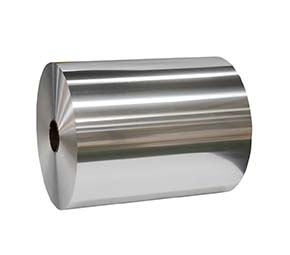.jpg)
Aluminum is the primary component for aluminum foil, aluminum comprises over 99% of foil's composition by weight. aluminum foil manufacturers source primary aluminum of some froms below.
Alumina (Al2O3): Aluminum ore extracted from bauxite deposits via the Bayer process, producing a white powdery alumina.
Primary aluminum: Alumina is electrolytically reduced in Hall-Héroult cells using the Hall process to produce the base aluminum material.
Even raw materials have strict impurity standards to limit the composition of their internal chemical components.Strict impurity standards ensure food-grade alloys maintain less than 1ppm of potentially toxic heavy metals like lead, cadmium or mercury. The aluminum is then refined and smelted to 99.5% purity minimum.
Alloy elements are also a key focus of aluminum foil thickness raw materials.Tiny amounts of alloying elements are added to the aluminum to enhance foil's properties:
Magnesium (~0.5% max): Renders the foil softer for forming yet maintains strength. Too much mg causes surface issues.
Manganese (~0.5% max): Controls aluminum grain structure during thermal treatments like annealing without compromising formability.
Chromium (~0.1% max): Limits grain growth during annealing for consistent barrier qualities across large foil widths.
Strict dosing and metallurgical analysis verifies alloy homogeneity and compliance with FDA limits for indirect food additives.
Aluminum foil thickness needs to go through multiple rolling processes during the production process, so the selection of lubricating oil is also key.
During hot and cold rolling processes to refine gauge, The following different lubricants are required.
Emulsified oils help roll mill platens grip foil without damage at speeds up to 1000mpm, imparting a mirror finish while achieving a thinner thickness.
Soaps and detergents used in degreasing rinse rolls after to eliminate residues before downstream processes.
Organic binders help adhere coatings or backing materials during lamination. Only FDA-affirmed lubricants contact the aluminum surface.
Aluminum foil also could coatings & laminates When the foil requires functional enhancements, Other raw materials will also be needed.
Polymer coatings for printability, adhesion or barrier. Common selections include EAA, EVA or LDPE.
Paper, plastic or foil laminates to engineer physical or chemical barrier properties.
Adhesives like solventless acrylics secure multi-layer constructions at precise aluminum foil thickness.
To summarize, the sterling sanitary and protective credentials of food grade aluminum foil jumbo rolls are supported by stringent control over high-purity aluminum, reduced alloying additives, and authorized supplementary elements. Proper raw material procurement is the first step in ensuring overall food safety.
Although aluminum foil jumbo rolls looks the same, different uses require different aluminum foil alloy states. Aluminum foils of different alloys have different chemical compositions. Next, we will explore the effects of different chemical compositions on the performance of aluminum foil.
.jpg)
The precise chemical makeup of raw materials for aluminum foil has a significant impact on the physical characteristics that determine its suitability for various applications. Minor adjustments to the alloy formula can meaningfully alter properties like strength, flexibility and barrier performance.
Purity Level is an important detection index of raw materials for aluminum foil.
Pure aluminum serves as the baseline composition, but achieving the highest possible purity maximizes performance:
Food-grade foil requires 99.5% minimum aluminum content to preclude contaminant migration into food. Lower purity foils are more brittle,therefore, it is easy to break when folded.Aluminum foil for food needs to be folded into various shapes to perfectly wrap food, so food-grade aluminum foil has higher requirements on the purity of aluminum.
Achieving 99.99% purity through multiple refining passes enhances formability for deep drawing complex shapes without cracking or work hardening.
Maximum purity also optimizes density for creating a near-impermeable barrier to gases like oxygen and aromas crucial for food preservation.High-density aluminum foil can effectively prevent the intrusion of water vapor and oxygen, thereby protecting the taste of food and extending the shelf life.
Magnesium is also a necessary element.Magnesium transforms aluminum's texture once alloyed.
0.2-0.5% magnesium confers workability, plastic deformability and ease of rolling without compromising barrier traits. Can effectively reduce production difficulty and improve yield while protect the quality of the aluminum foil.
Over 0.5% generates surface defects from intermetallic compositions which weaken the matrix and promote pinholing over lifespan.
Magnesium also reduces surface roughness for superior sealability in laminate structures or where foil directly contacts food.
Adding manganese to aluminum foil can also increase its chemical properties,manganese governs grain structure formation:
0.1-0.5% manganese retards recrystallization, preserving high elongation properties even after heat treatment and converting.
Content beyond 0.5% induces excessive work hardening, diminishing formability during processing and diminishing recyclability.
Manganese further controls surface texture, favoring the ultra-smooth classification essential for multi-layer lamination bonding.
To summarize, precise aluminum content tailoring combined with cautious alloying with magnesium and manganese results in foil compositions that maximize the varied physical properties essential to a wide range of packaging applications and industrial purposes. Ongoing research advances alloy science, allowing for the development of increasingly better performance specialist alloys.
Food grade aluminum foil has different uses,such as Household,for making food containers,for making food bags.Among these,the Household aluminum foil usage is the most common.
Household aluminum foil has several use in both commercial and home kitchen settings. It is frequently used to wrap and store leftovers, baking aluminum foil casseroles and baked goods, grill meats and vegetables, and roast potatoes and other produce. Baking aluminum foil acts as a good moisture and oxygen barrier, helping to keep food fresh. It is also lightweight, affordable, and simple to operate. However, some disadvantages include the restricted recyclability of foil laminates and the risk of aluminum leaking into acidic foods during long-term storage or at high temperatures. Overall, food-grade aluminum foil has various benefits for keeping prepared meals and components fresher for longer when used as instructed and in moderation as part of a healthy diet.





